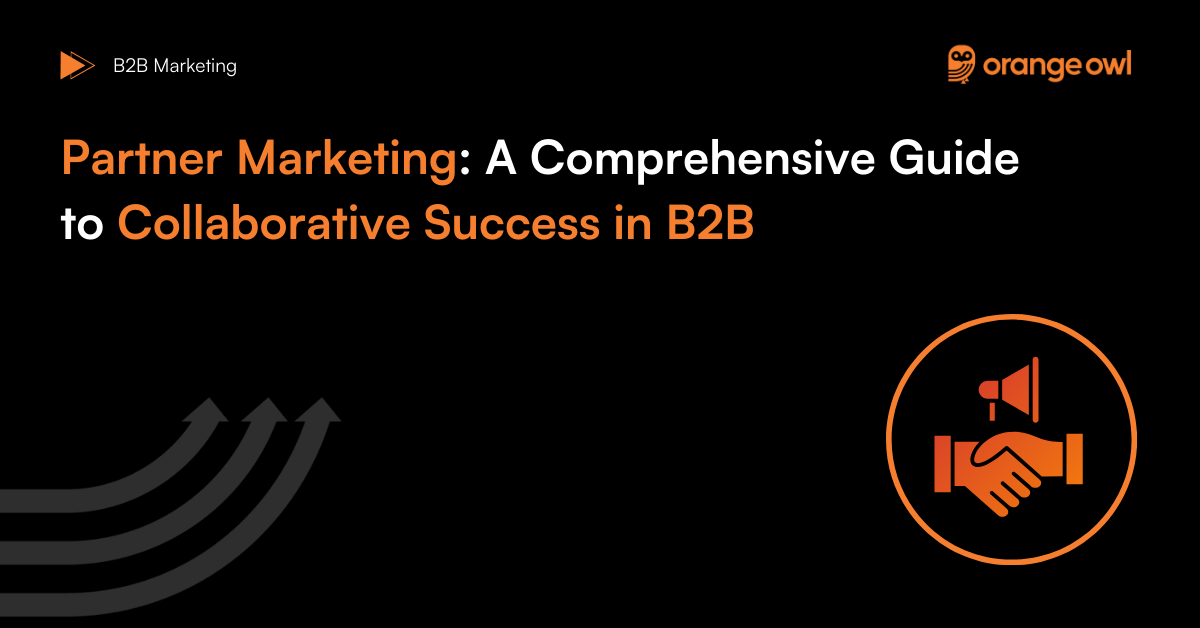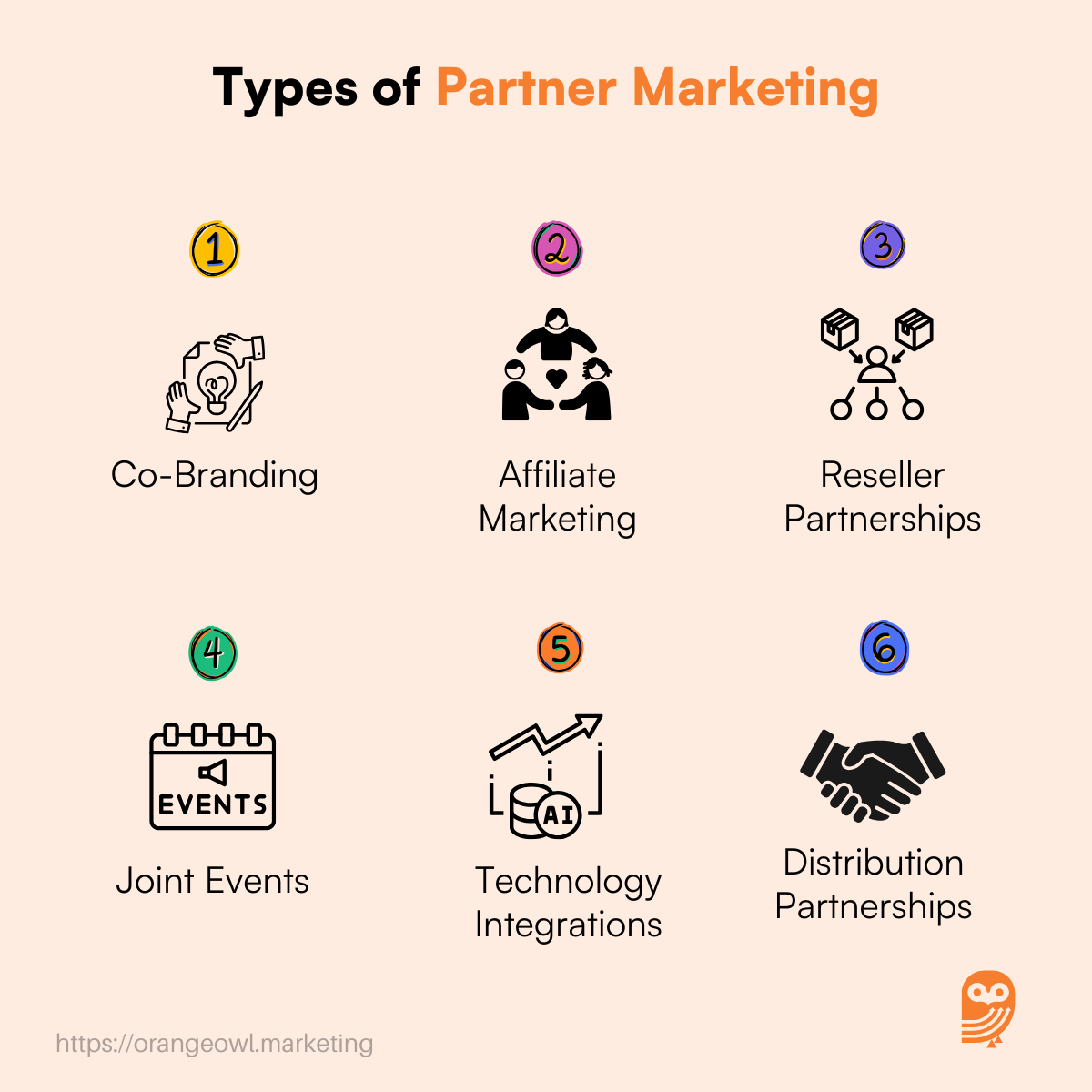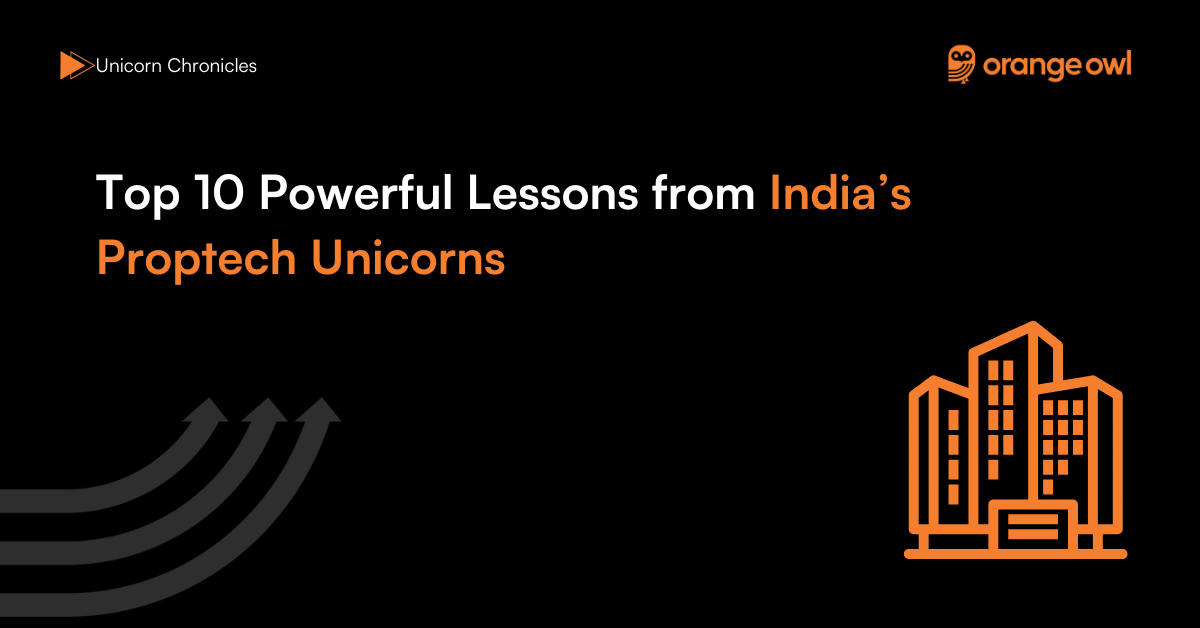Partner Marketing: A Comprehensive Guide to Collaborative Success in B2B
Vivek Goel
December 3, 2024

Table of Contents
Introduction
In the competitive world of B2B marketing, businesses are constantly seeking innovative ways to expand their reach, build credibility, and drive revenue. One such strategy that has stood the test of time is partner marketing. This approach leverages the strengths of two or more companies to achieve mutual goals, creating a win-win situation for all parties involved. Whether it’s co-branded campaigns, joint events, or strategic alliances, partner marketing is a powerful tool for businesses aiming to scale efficiently.
This blog will explore the concept of partner marketing, its benefits, various types, best practices for implementation, challenges, and real-world examples of successful collaborations.
What is Partner Marketing?
Partner marketing refers to a collaborative approach where two or more companies join forces to promote their products or services. These partnerships can take various forms, such as co-branding, affiliate marketing, reseller agreements, or joint product development. The core idea is to pool resources, expertise, and audiences to achieve shared objectives, such as increasing brand awareness, generating leads, or driving sales.
For instance, a software company might partner with a hardware manufacturer to offer an integrated solution, or two SaaS providers might collaborate on a webinar to showcase how their tools complement each other.
Benefits of Partner Marketing
1. Expanded Reach
By partnering with another company, businesses can tap into a broader audience that they might not have reached on their own. This is particularly beneficial for startups or companies entering new markets.
2. Shared Costs and Resources
Partner marketing allows companies to share the costs of campaigns, events, or product development, making it a cost-effective strategy. Additionally, they can leverage each other’s expertise and resources, such as technology, manpower, or marketing channels.
3. Enhanced Credibility
Collaborating with a trusted partner can boost your brand’s credibility and reputation. When a respected company vouches for your product or service, it increases trust among their audience.
4. Increased Innovation
Partnerships often lead to creative ideas and innovative solutions that might not have emerged within a single organization. This synergy can result in unique offerings that stand out in the market.
5. Higher Conversion Rates
Targeting a partner’s warm audience—people already familiar with and trusting the partner—can lead to higher conversion rates compared to cold outreach.
Types of Partner Marketing
1. Co-Branding
Two or more brands collaborate to create a product, service, or campaign under both their names.
Example: Nike and Apple’s partnership on the Nike+ product line.
2. Affiliate Marketing
A company rewards its partners (affiliates) for bringing in leads or sales through their marketing efforts.
Example: Amazon’s Affiliate Program allows individuals and businesses to earn commissions by promoting Amazon products.
3. Reseller Partnerships
One company sells another’s products as part of its own portfolio, often adding value through bundling or customization.
Example: Managed service providers (MSPs) reselling cloud storage solutions.
4. Joint Events
Companies co-host events such as webinars, workshops, or conferences to attract a shared audience.
Example: HubSpot and LinkedIn hosting joint marketing webinars.
5. Technology Integrations
Businesses create integrated solutions by combining their technologies to offer enhanced value to customers.
Example: Salesforce and Slack’s integration to streamline team collaboration.
6. Distribution Partnerships
One company leverages another’s distribution network to sell its products or services.
Example: Beverage brands partnering with retail chains for product placement.

Best Practices for Effective Partner Marketing
1. Choose the Right Partner
Selecting a compatible partner is critical to the success of a partnership. Partners should share similar values, complement your offerings, and cater to overlapping target audiences. Misaligned partnerships can lead to conflicts, inefficiencies, and brand dilution.
Example: HubSpot and LinkedIn partnered to create joint webinars and share resources. This worked because both companies target B2B marketers and aim to simplify lead generation.
Tips for Implementation:
- Research potential partners’ values, audience demographics, and business goals.
- Use data-driven tools to evaluate alignment in market reach and expertise.
- Avoid partnering solely based on financial gains; focus on long-term synergy.
2. Define Clear Objectives
Ambiguous goals can derail the partnership. Both parties must agree on clear, measurable objectives and establish KPIs to track progress. Shared clarity ensures alignment and minimizes misunderstandings.
Example: Microsoft and Adobe’s integration of Dynamics 365 with Adobe Marketing Cloud focused on creating a seamless solution for B2B marketing and CRM users. Both companies aligned their goals to improve user experience and expand their customer base.
Tips for Implementation:
- Draft a partnership agreement that outlines goals, responsibilities, and success metrics.
- Use SMART (Specific, Measurable, Achievable, Relevant, Time-bound) goals to guide the collaboration.
3. Develop a Shared Strategy
Both partners must collaborate on campaign planning and execution to ensure coherence. Joint strategies should detail roles, timelines, budgets, and deliverables, ensuring accountability on both sides.
Example: Red Bull and GoPro co-created content, such as the “Stratos” jump, that showcased both brands’ adventurous spirit. Their shared vision and execution strategy resulted in a highly successful campaign.
Tips for Implementation:
- Create a joint marketing calendar and use collaborative tools for coordination.
- Assign specific roles to avoid overlaps and ensure efficient execution.
4. Leverage Each Other’s Strengths
A successful partnership capitalizes on the unique strengths of both parties. One partner might excel in technology while the other has strong distribution channels, creating a mutually beneficial setup.
Example: Apple and MasterCard partnered to launch Apple Pay. Apple brought innovative technology, while MasterCard offered extensive payment network expertise. Together, they revolutionized digital payments.
Tips for Implementation:
- Conduct a SWOT analysis for both companies to identify complementary strengths.
- Focus on mutually beneficial aspects like expertise, resources, or market presence.
5. Maintain Transparent Communication
Regular communication is essential to keep the partnership aligned and address challenges promptly. Transparency fosters trust and ensures smooth collaboration.
Example: Spotify and Starbucks partnered to enhance the in-store experience, with clear communication about goals and expectations for their music-driven strategy.
Tips for Implementation:
- Schedule regular meetings to review progress, share updates, and address issues.
- Use collaboration tools like Slack or Asana to ensure real-time communication.
6. Focus on the Customer
Customer satisfaction should remain the cornerstone of any partnership. Collaborations that fail to add value to the customer are unlikely to succeed.
Example: Uber and Spotify collaborated to let riders customize their ride playlists, creating a memorable and personalized user experience.
Tips for Implementation:
- Conduct surveys or gather customer feedback to refine joint offerings.
- Ensure campaigns highlight customer benefits rather than the partnership itself.
7. Track and Optimize Performance
Measuring the performance of the partnership is critical for continuous improvement. Monitoring KPIs like lead generation, sales, or brand awareness can help refine future strategies.
Example: Coca-Cola and McDonald’s continuously analyze sales data from their co-branded campaigns to refine bundling strategies and maximize impact.
Tips for Implementation:
- Use analytics tools like Google Analytics or HubSpot to measure campaign ROI.
- Schedule quarterly reviews to discuss performance metrics and optimize strategies.
Challenges in Partner Marketing and How to Overcome Them
1. Misaligned Goals
Partners may have differing objectives, leading to conflicts.
Solution: Clearly define shared goals and establish mutual benefits at the outset.
2. Unequal Effort or Contribution
One partner might invest more resources than the other, causing friction.
Solution: Set clear expectations and create an equitable agreement.
3. Brand Dilution
Poorly executed partnerships can harm a brand’s reputation.
Solution: Ensure the partner’s values and image align with your brand identity.
4. Communication Gaps
Lack of coordination can lead to missed opportunities or inefficiencies.
Solution: Schedule regular check-ins and use collaborative tools for seamless communication.
5. Measuring ROI
Quantifying the impact of a partnership can be challenging.
Solution: Use analytics tools to track metrics such as lead generation, engagement, and sales.
Partner Marketing Strategy and Program Design Using the ‘5 Ps’ Framework
A well-executed partner marketing strategy can elevate your brand’s reach and drive sales growth. However, crafting an effective program requires careful consideration of both your goals and your partners’ needs. By applying the ‘5 Ps’ framework—Purposeful, Plausible, Possible, Pleasant, and Profitable—you can build a partner marketing program that delivers mutual success.
Let’s dive into each ‘P’ to design a program that works.
1. Make It Purposeful
Your goal in partner marketing is clear: increased sales and reach. But what’s in it for your partners? They often juggle multiple brands, so your program needs to stand out. Incentives are crucial but not the sole motivator. Consider other drivers like market development, access to expertise, or alignment with Environmental, Social, and Governance (ESG) goals. Understand what resonates most with your partners and design your program accordingly.
Best Practices for Purposeful Partner Marketing
- Meaningful: Align incentives with what truly motivates your partners.
- Ethical: Support partners’ ESG priorities where possible.
- Powerful: Double down on incentives that have the greatest impact.
Implementation Tips
- To Partner: Conduct thorough research to understand partners’ goals and create a program that stands apart.
- Through Partner: Align your branding and product positioning with ethical and meaningful messages that resonate with end customers.
2. Make It Plausible
Setting ambitious sales goals is great, but they need to be realistic and actionable. Clarify the program’s objectives and ensure partners have the skills and resources to meet them. A strong foundation includes clear communication about expectations, training, and measurable outcomes.
Best Practices for Plausible Partner Marketing
- Capable: Provide education to close knowledge gaps and enhance partner expertise.
- Mindful: Account for partners’ existing product portfolios when structuring your program.
- Coordinated: Highlight cross-sell and upsell opportunities for maximum value.
Implementation Tips
- To Partner: Equip partners with industry insights and product knowledge to boost confidence and sales effectiveness.
- Through Partner: Avoid overpromising; ensure marketing materials and messaging are clear, credible, and aligned with reality.
3. Make It Possible
A successful partner program requires removing barriers and ensuring your partners have the tools and support they need. Apply models like ADKAR (Awareness, Desire, Knowledge, Ability, and Reinforcement) to ensure partners are prepared to succeed.
Best Practices for Possible Partner Marketing
- Systematic: Regularly evaluate what partners need and provide actionable support.
- Open: Encourage innovation and replicate effective sales techniques across your partner network.
- Supportive: Offer co-brandable assets, joint campaigns, and other resources to lighten the marketing load for partners.
Implementation Tips
- To Partner: Establish clear processes for updates and program changes to avoid confusion.
- Through Partner: Create user-friendly campaign kits with comprehensive resources to simplify co-marketing efforts.
4. Make It Pleasant
Building strong relationships with partners is key to long-term success. Treat them with respect, maintain professionalism, and minimize unnecessary disruptions. A positive experience ensures partners remain loyal and motivated.
Best Practices for Pleasant Partner Marketing
- Easy: Develop straightforward tools and processes for program participation.
- Standardized: Limit frequent or unnecessary changes to reduce partner frustration.
- Proactive: Communicate well in advance about new campaigns or updates.
Implementation Tips
- To Partner: Use Quarterly Business Reviews (QBRs) to align goals, provide education, and gather feedback.
- Through Partner: Build trust through certifications, partner directories, and recognition programs like awards.
5. Make It Profitable
At its core, partner marketing must drive profitable growth for both parties. Designing a program with robust incentives, diverse opportunities, and cutting-edge tools ensures shared success.
Best Practices for Profitable Partner Marketing
- Robust: Enable partners to grow market share, reduce costs, and enhance expertise.
- Diverse: Cater to different partner goals and expertise levels through flexible program structures.
- Savvy: Keep partners competitive by equipping them with advanced marketing technologies and strategies.
Implementation Tips
- To Partner: Reassure partners of mutual benefits by acting in their best interest and maintaining transparency.
- Through Partner: Understand partners’ market models (resellers, integrators, distributors, etc.) and tailor support accordingly.
Examples of Successful Partner Marketing Campaigns
Spotify and Starbucks
Spotify partnered with Starbucks to enhance the in-store music experience while promoting its platform. Starbucks employees received premium Spotify accounts to create playlists, blending brand experiences.
GoPro and Red Bull
These two adventure-driven brands collaborated on events like the “Stratos” jump, creating buzz while aligning their energetic brand identities.
Microsoft and Adobe
The companies integrated their solutions—Microsoft Dynamics and Adobe Marketing Cloud—to provide a seamless marketing and CRM experience for B2B customers.
Coca-Cola and McDonald’s
This iconic partnership leverages product bundling and co-branded advertising, driving mutual success across decades.
Conclusion
Partner marketing is a powerful strategy for B2B businesses looking to expand their reach, build trust, and drive growth. By collaborating with like-minded companies, businesses can achieve more than they could individually, leveraging shared resources and audiences to create impactful campaigns.
However, success in partner marketing requires careful planning, clear communication, and a customer-first approach. By choosing the right partners, setting clear objectives, and monitoring performance, businesses can unlock the full potential of this collaborative strategy.
As the B2B landscape continues to evolve, partner marketing will remain a cornerstone of innovative and effective marketing strategies. Embrace the power of partnerships to take your business to new heights!
Frequently Asked Questions on Partner Marketing
Traditional marketing strategies often focus solely on an individual company’s efforts to promote its products or services through advertisements, email campaigns, or content marketing. Partner marketing, on the other hand, involves collaboration between two or more companies to leverage combined resources, audiences, and expertise. For example, while a company may launch a solo ad campaign, partner marketing might involve co-hosting an event or launching a co-branded product that taps into the customer base of both partners, offering a broader reach and enhanced credibility.
Industries with complementary products or services, such as technology, retail, food and beverage, and entertainment, benefit significantly from partner marketing. For example, in the tech industry, companies like Salesforce and Slack have partnered to create integrated solutions, enhancing value for customers. In retail, partnerships like H&M and designer brands for exclusive collections attract diverse audiences. Partner marketing is also impactful in industries where trust and credibility are critical, such as financial services and healthcare.
Yes, small businesses can leverage partner marketing effectively by collaborating with local or niche companies. For instance, a local bakery could partner with a coffee shop to offer bundled deals. Small businesses benefit by pooling limited resources, expanding their reach, and sharing the costs of marketing initiatives. The key for small businesses is to choose partners that align closely with their values, goals, and target audience.
The success of a partner marketing campaign can be measured using metrics such as:
- Revenue Growth: Did the campaign increase sales?
- Lead Generation: How many new leads were generated?
- Customer Engagement: Was there a rise in website traffic, email sign-ups, or social media activity?
- Return on Investment (ROI): Compare the campaign’s cost to its financial return.
For example, after a co-hosted webinar, metrics like attendee numbers, post-event sign-ups, and sales conversions can indicate its success.
Technology plays a crucial role by streamlining communication, tracking performance, and automating processes. Tools like partner relationship management (PRM) software help manage partnerships by offering dashboards for tracking metrics, sharing resources, and fostering collaboration. For instance, using a PRM platform, a company can provide partners with co-branding templates, monitor campaign results, and share leads seamlessly.
Businesses can ensure value alignment by conducting thorough due diligence, including:
- Reviewing the partner’s mission, vision, and past campaigns.
- Analyzing customer feedback to gauge reputation.
- Hosting exploratory meetings to discuss goals and principles.
For example, a company focused on sustainability should partner with brands that share similar environmental priorities, ensuring that the collaboration resonates with audiences.
Some common mistakes include:
- Lack of Clear Objectives: Ambiguity in goals can lead to conflicts.
- Choosing the Wrong Partner: Misaligned values or target audiences can harm both brands.
- Poor Communication: Lack of updates or unclear roles can derail campaigns.
For instance, if two brands target vastly different demographics, a partnership might fail to resonate, leading to wasted resources. Avoiding these pitfalls ensures smoother collaborations.
To foster long-term partnerships, companies should:
- Maintain Open Communication: Regular check-ins help address issues promptly.
- Recognize Contributions: Acknowledge and reward partner efforts.
- Evolve Together: Adapt strategies to changing market conditions.
For example, quarterly business reviews (QBRs) can be used to evaluate progress, share insights, and plan future campaigns.
Conflicts can arise from misaligned goals or unequal contributions. To resolve these issues:
- Establish Clear Agreements: Set roles, expectations, and KPIs upfront.
- Communicate Openly: Address concerns immediately through transparent discussions.
- Seek Win-Win Solutions: Revisit agreements to ensure mutual benefit.
For instance, if one partner feels they are contributing more resources, renegotiating the terms to balance efforts can restore harmony.
Partner marketing can offer customers unique value by combining the strengths of both partners. For example, a collaboration between Spotify and Starbucks allowed customers to enjoy curated playlists, enhancing their in-store experience. Joint campaigns, such as bundled products or services, provide customers with convenience, cost savings, and innovation, which contribute to a positive brand perception and loyalty.


